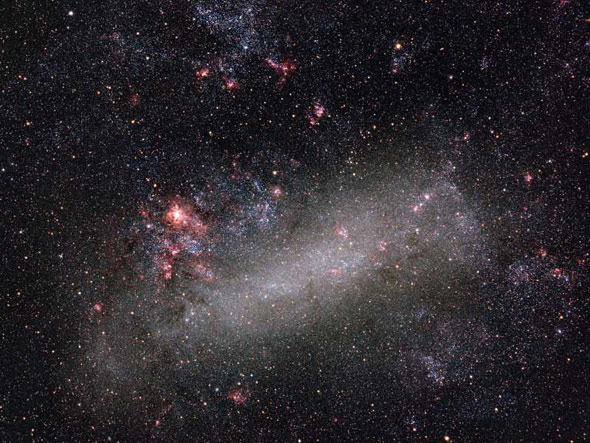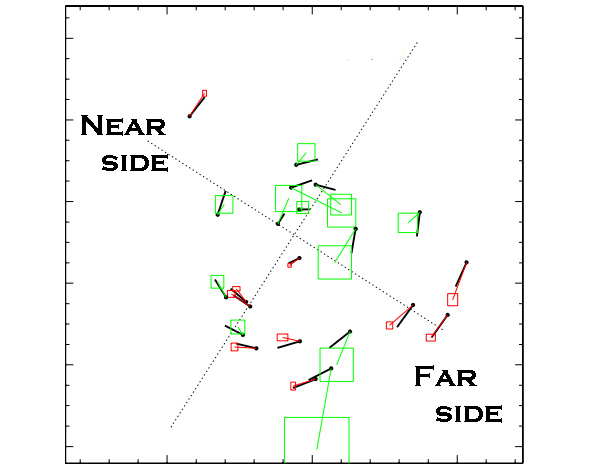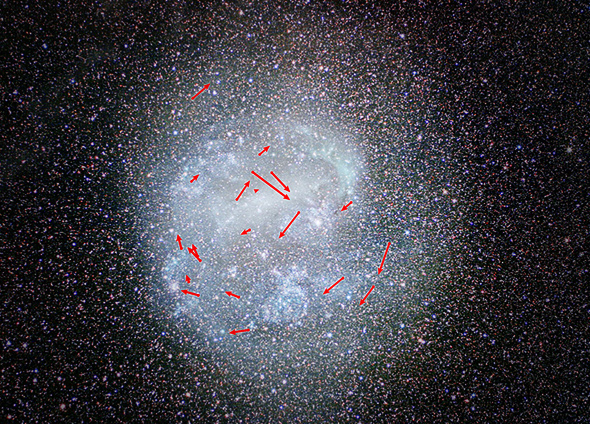Spinning Up a Nearby Galaxy

Spinning Up a Nearby Galaxy
Photo by NASA, ESA, R. van der Marel (STScI), and N. Kallivayalil (University of Virginia). Click to galactinate.
Well, this is simply too cool: For the first time,
astronomers have directly measured the rotation of another galaxy. How?
By actually measuring the stars in that galaxy physically move over
time!
This really is pretty phenomenal work, and scientifically it’s pretty important, too. Let me ‘splain.
First, the galaxy in question is the Large Magellanic Cloud (or LMC
to those of us in the know), an irregular-looking fuzz ball that just so
happens to be one of the closest galaxies in the Universe. It actually
orbits our Milky Way like the Moon orbits the Earth. Its distance is
about 160,000 light years away—compare that with the Andromeda Galaxy,
the nearest large spiral to us, which is 2.5 million light years distant.
There are billions of stars in the LMC, and they all orbit the center
of the galaxy. It’s a bit like the way planets orbit the Sun, but in
our solar system the Sun has essentially all the mass, and therefore all
the gravity. In a galaxy, the mass is distributed throughout in the
form of stars and gas, giving an overall gravitational field, not a
concentrated one. Still, this means stars orbit the center, and their
speed depends on the mass of the galaxy and their distance from that
center.
The speeds sound ridiculously huge: An average star might be zipping
around at 90 kilometers per second, which is 200,000 mph! But remember,
in human terms the LMC is a long way off, and that distance shrinks that
velocity to something that’s pretty small and hard to detect. Think of
how fast an airplane flies, but how slowly one appears to move when it’s
far away, and you get the picture.

Photo by Wei-Hao Wang(IfA, U. Hawaii)
We do have an indirect way to detect that motion: the Doppler effect.
If a star is heading more-or-less toward us, its light gets shifted to
the blue end of the spectrum, and if it moves away the light gets
redshifted. As a star orbits the galaxy center, it spends half its orbit
heading toward us, and half heading away, and this is betrayed by its
Doppler shift. We’ve measured the motions of thousands of stars in the
LMC this way, but it doesn’t give us the physical direction of the
motion; a star heading away from us at an angle is difficult to
distinguish from one heading directly away from us. We need that space
motion to get the actual directions the stars are moving, but that is so
small it’s incredibly difficult to measure.
But we have an extraordinary tool at our disposal: Hubble. Not only
does it have excellent eyesight, capable of detecting small changes in a
star’s position even in the LMC, but Hubble has also been in use a long
time, providing a nice long baseline. After all, if the stars are
moving, the longer you wait the more they move! In this case, many years
elapsed between observations, providing good coverage of the stars’
motions.
For this study,
the astronomers observed nearly 6,800 stars over about seven years.
During that time, the teeny tiny amount those stars moved was enough for
Hubble to detect. And what they found was pretty dang cool: The stars
in the LMC can be seen to orbit the center of the galaxy in a clockwise
manner. Not only that, but the overall rotation tells us more about the
galaxy, too. For example, although it looks like an irregular mess, the
stars appear to be more or less in a flat disk, like Milky Way stars
are.

Plot by van der Marel and Kallivayalil, from the paper.
That disk is tilted to us by about 40°, so we’re looking down on it
at an angle. But it gets a bit more complicated: When the astronomers
split the stars up by age, they found that older stars tend to be in a
slightly different plane than the younger ones, like there are two
separate disks of stars. It’s not clear why that might be, though I
suspect it may be linked to another problem …
The center of a galaxy can be found in many ways. One way is to look
at all the gas orbiting it, and use that information to map out the
location of the galaxy’s center. Another is to use the motion of the
stars themselves, measured as done in this new study (see the picture
above). A third way is to find the center using the combined light of
all the stars, what’s called the photometric center. Because the galaxy
is a bit messy (and has what’s called a bar, a more-or-less rectangular
clump of stars across its middle), the photometric center is off a bit
compared to the other two. This may be because the galaxy recently had a
close encounter with another galaxy, called the Small Magellanic Cloud
(guess why?). This near passage may have poked a cosmic stick into the
LMC, riling it up and distorting its shape. This would explain the
difference between the centers, and it may also explain why young and
old stars appear to be laid out in slightly different disks. Gas clouds
may have been disturbed in the encounter, so stars born from them could
have been born in slightly different orbits from the older generation.
I’m speculating here, but it makes a sort of sense.
There’s actually quite a bit more learned from this study, including
the overall motion of the LMC in the sky, its mass, the distribution of
its mass, and so on. All of this is important for us to understand,
because the galaxy is close by and used in many ways as a proxy for more
distant galaxies. It’s our baseline, in a sense, and the more we know
about it the better we can understand the more distant Universe.
And I’m all for that. Up until recently we didn’t know much about the
cosmos outside our galaxy because we simply couldn’t study it in detail
(heck, we were unsure of the nature of our own galaxy until less than a
century ago). Now, though, we have the tools and the means to get to
know it a lot better, and to me that’s one of the greatest achievements
of our species. We were born of this Universe and we’re part of it.
Understanding it better should always be at the top of our list of
priorities.
Labels: Astronomy, Nature, Space, Space Science, Universe


0 Comments:
Post a Comment
<< Home